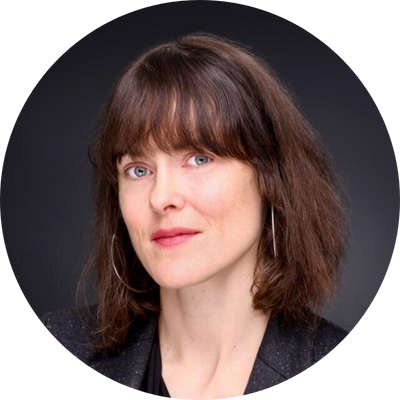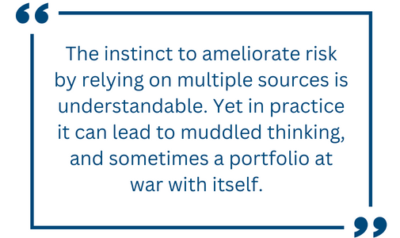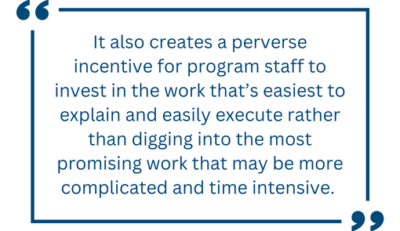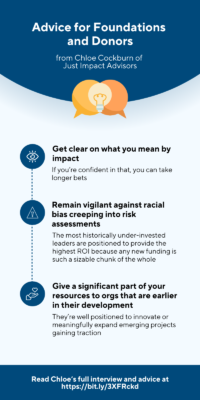An Interview with Chloe Cockburn of Just Impact Advisors

Chloe Cockburn, president of Just Impact Advisors
Recently, Aspen Institute Vice President and PSI Executive Director Jane Wales began to explore the role and potential of philanthropic “field strategists.” These strategists bring deep domain expertise, field insight, and trusted relationships to the philanthropic marketplace. Can they play a role to increase philanthropy’s efficiency and effectiveness? Can their ability to identify the biggest gaps and collaborate with people in the field help increase the impact of a donor or foundation’s grant portfolio?
Today we continue Wales’s two-part interview with Chloe Cockburn of Just Impact Advisors. Chloe offers advice to philanthropists on engaging and leveraging a field strategist to maximize their giving impact.
To read Part I of this interview, click here.
*PSI has edited this interview for length.
Q. Based on your experience as a field strategist, what are some ideas you have for improving the philanthropic marketplace?
My top recommendation for donors: they should rely on a person with field experience to develop a coherent giving strategy and give them the authority to execute that strategy. Much philanthropic giving by individual donors gets mediated through donor advisory processes that use a crowd-sourcing model to identify opportunities. Consultants may speak with dozens of people in the field and in philanthropy to produce recommendations.

The instinct to ameliorate risk by relying on multiple sources is understandable. Yet in practice it can lead to muddled thinking, and sometimes a portfolio at war with itself. Each source might have a good analysis, but the value of multiple recommendations can be less than the sum of their parts. It also misses the chance for a single strategist to put together a portfolio in which grantee organizations can leverage each other’s work and create powerfulsynergies.
The giving vehicle’s nature is less important. Rather, ensure that there is an individual who leads and deeply understands the strategy and is making decisions about resource allocation. This person can bring a deep ecosystem knowledge to ensure that multiple grants are working collectively to achieve major goals.
Q. What rules of thumb should philanthropists and grantmakers consider for the size and duration of their grants?
My experiences at Open Philanthropy have shaped my ideas. The organization was effective at maximizing staff time and resource efficiency. Open Philanthropy’s Holden Karnofsky has written extensively on these topics. One example is this post, solving for the problem of how to give away a lot of money with a small team.
I’d like to see donors use better rubrics to determine the right size of an overall portfolio and the grants within it. Clarity on this will improve transparency, collaboration, and impact across the philanthropic marketplace.
What tends to happen now is that both portfolio sizes and grant sizes hover around an arbitrary number: for example, $20 million a year for a portfolio and $200,000 a year for a grant. This provides few options for organizations that need a surge of growth capital to put an idea on the map. It limits the field’s growth. There also are practices that limit grant sizes. For example, funders may have a policy of not giving more than 30% of an organization’s budget or insist on splitting grants between three to four funders to spread the risk that a grant may not succeed. The $1 million+ per year grants tend to go to well-established organizations that already have major budgets (over $10 million a year). They often evolve to become less innovative over time. I’d like to see more $1 million+ a year grants go to organizations with a total budget of $3–10 million. That type of scaling investment is so important to allow organizations to step into their full potential.
Q. What are some best practices that donors and grantmakers could adopt that would allow them to avoid these pitfalls?
First, a donor who is very passionate about an issue should consider giving at least 1% of their net worth per year to that issue.
Tying the allocation to percentages removes the agonizing question of how much is enough. It also gets us away from tying funding to the size of a charitable foundation rather than total assets. It removes the ego side of big money giving, where we assume that a billionaire giving north of $100 million is a major statement. Instead, it could be a modest percentage.
Not every issue area has enough stellar giving opportunities to absorb the cash amounts that donors would unleash if they gave this way. But I think donors would be pleasantly surprised by the new impactful, creative horizons that would open. For example, many organizations would benefit from purchasing real estate for offices, retreat centers, housing for fellows and trainees. Yet they have never proposed this to donors — the upfront capital costs seem enormous compared to operating budgets. Think how transformative it would be for more of our strongest social change organizations to own real assets!
Second, for every $10 million that a donor gives on an issue, there should be at least one grant more than $1 million per year that’s focused on that issue. Reserving bigger grants for a few major national organizations does not suffice. This helps address the problem of everyone looking to someone else to provide the muscular funding an organization needs to grow. It also encourages donors to back up their excitement about grantees with substantial funding.
Q. Are there any lessons to be learned from how startup funding is structured?
If you fund an organization at a subsistence level when it’s ready for significant growth, it will never reach its full potential. Our field is in desperate need of growth funders, and I would advise that donors incorporate startup-funding frameworks into their philanthropy: pre-seed, seed, Series A, Series, B, Series C, and possibly Series D. Few funders have assessed which funding tranches — and associated risk profiles — best suit them. Doing so requires an analysis of how much in-depth expertise they bring to the work (especially important for identifying early prospects for pre-seed and seed funding) and whether they want to focus on large or small grants. The benefits of funders identifying which kind they are allocating from the above categories are that:
- It would make clear whether the field is starved for a category of funding if it appears that no donors or very few donors occupy a particular
- Donors doing different funding tranches could clearly see collaboration opportunities, creating a funding pipeline for an organization progressing from pre-seed through seed, to series A and beyond, and
- It may reduce the incidence of organizations that fit series A or B criteria being stuck with grant amounts that are more appropriate to seed funding.
Q. What practices need to change inside foundations so funding decisions can be more effective?
 Program staff spend an enormous amount of time justifying their strategy and recommendations to management and to the donor. At some foundations, this can take up a full quarter of the year. This is wildly inefficient. It also creates a perverse incentive for program staff to invest in the work that’s easiest to explain and easily execute rather than digging into the most promising work that may be more complicated and time intensive.
Program staff spend an enormous amount of time justifying their strategy and recommendations to management and to the donor. At some foundations, this can take up a full quarter of the year. This is wildly inefficient. It also creates a perverse incentive for program staff to invest in the work that’s easiest to explain and easily execute rather than digging into the most promising work that may be more complicated and time intensive.
If the donor and management are confident in their program staff hires, they should defer to them to execute on a strategy. They should limit their in-depth and program-wide synching up to once every 3 years. The risk here is that the strategy will veer off course or that the donor will become so alienated from it that they no longer feel invested. A solution is asking the program staff to provide in-depth explanations for a small subset of grants that are representative of the wider portfolio. This allows management and donors to track their thinking and ensure that it’s still in line with overall giving priorities. It also ensures that program staff have plenty of time to do their work.
Q. Any closing ideas for foundations and donors?

Yes!
– Get clear on what we mean by impact. If we’re confident in that, we can take longer bets.
– Remain vigilant against racial bias creeping into risk assessments. Black leaders are often treated as being more “risky” bets. One rigorous framework to change this is return on investment. The most historically under-invested leaders are positioned to provide the highest ROI because any new funding is such a sizable chunk of the whole. That makes them a better bet!
– The most established institutions are best positioned to access funds through relationships and their development and communications capacity. However, they are least well-positioned to innovate. Funders often focus on adding dollars to what’s already happening rather than innovating or meaningfully expanding emerging projects that are getting traction. Funders can counter this by giving a significant part of their resources to organizations that are earlier in their development.

